‘Apex Legends’ Is Complicated, But It Just May Be the World’s Craziest Esport
It’s a frigid Sunday in Sapporo, a city tucked away amid the mountains in the Hokkaido region of Japan. Days of snowfall have covered the roads and sidewalks with ice, but that doesn’t stop the sea of people trudging their way to the Daiwa House Premist Dome, a soccer stadium that can house over 40,000 people that was previously a site for both the Summer and Winter Olympics. On this day, however, the 13,000 or so fans aren’t braving the weather for football, they’re here for one of the world’s fastest growing esports: Apex Legends.
This is the Apex Legends Global Series, the fourth since 2020, bringing together competitors from all over the world for a championship tournament consisting of 40 teams competing for a $2 million prize. It’s a massive spectacle for Japan, one of the biggest markets for Apex, and fans are pouring into the venue, some wrapped in flags and others in full cosplay, for the grand finals on the last of five days of ongoing competition.
When it’s all over, it’s said that over 30,000 people will have attended this year’s Global Series, which is frankly an insane number. But what’s the draw? How does a video game — especially one as young as Apex, which launched in 2019 — inspire this kind of devotion?
Apex Legends Global Series Year 4 was held in Sapporo, Japan from Jan 29 to Feb 2, 2025.
Courtesy of EA
Rolling Stone spoke with the people behind Apex Legends’ evolving esports scene, including players, casters, and the developers of the game itself, to understand how the 60-player battle royale has won the hearts of fans globally, and why something that might seem baffling at first might just have what it takes to become your new favorite esports obsession.
What is Apex Legends?
Launched in 2019, Apex Legends is a multiplayer first-person shooter from Respawn Entertainment. A free-to-play spin-off of the studio’s Titanfall series, it’s a sci-fi tinged battle royale wherein 60 players across two- or three-person squads face off on an island Hunger Games-style to be the last team standing. If that sounds familiar, it should. Battle royales have become hugely popular over the last few years following the success of PlayerUnknown Battlegrounds and Fortnite, with even huge existing franchises like Call of Duty adopting the format for its competitive esports modes.
That Call of Duty correlation is notable, too, as Respawn itself was founded by former members of Infinity Ward, the studio behind Call of Duty 4: Modern Warfare (2007) — the game that pretty much cemented how most first-person shooters have looked and played for nearly two decades. In many ways, the DNA of Call of Duty can be felt in Apex, primarily in how the game controls with its slick gunplay. But Apex itself is a different beast altogether, more reliant on lightning-fast player movement that borders on parkour, allowing for high-stakes acrobatics amid the mayhem of combat.
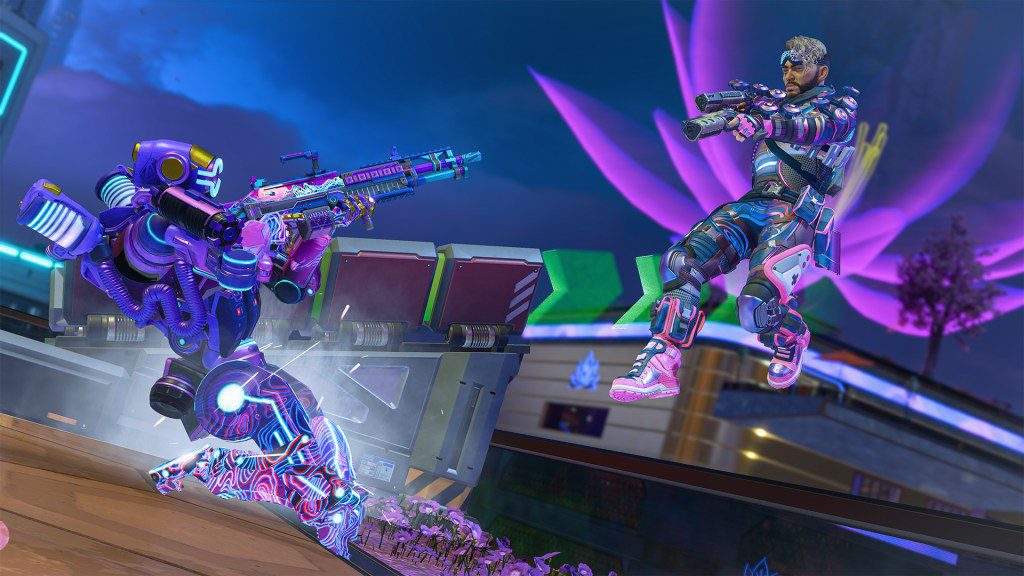
Apex Legends is a 60-player battle royale that blends aspects of many different games.
Courtesy of EA
Like Fortnite’s battle royale mode, the basic crux of Apex sees the different squads roaming a sprawling map (of which there are multiple, all with different terrains and dangers), gathering resources and completing minor objectives, all while trying to eliminate the enemy teams. As time passes, storms roll in, creating an ever-closing iris that ratchets up the tension as combatants are continually forced into tighter quarters.
It sounds intense, and it is, partially because of the inherent chaos of the battle royale formula. Even with a huge map, the sheer number of players at once make for a consistent onslaught of small skirmishes that chain together to create the story of each match, and both the environmental hazards and openness of each map make it difficult to predict exactly where the next the threat will come from.
John Larson, a game designer for Apex, believes that the unpredictability of the format is key to its excitement, even if it can be tough to grasp at first. “I think the competitive element sets us apart,” he says. “There’s this sort of oxymoron [where] people think, ‘It’s a battle royale; how can that be competitive?’ Because it’s an inherently random genre. Every game is different, but Apex strikes a balance of mitigating some of the randomness with learned skills and extra layers of depth to it, and mastery that makes it a thousand-hour game.”
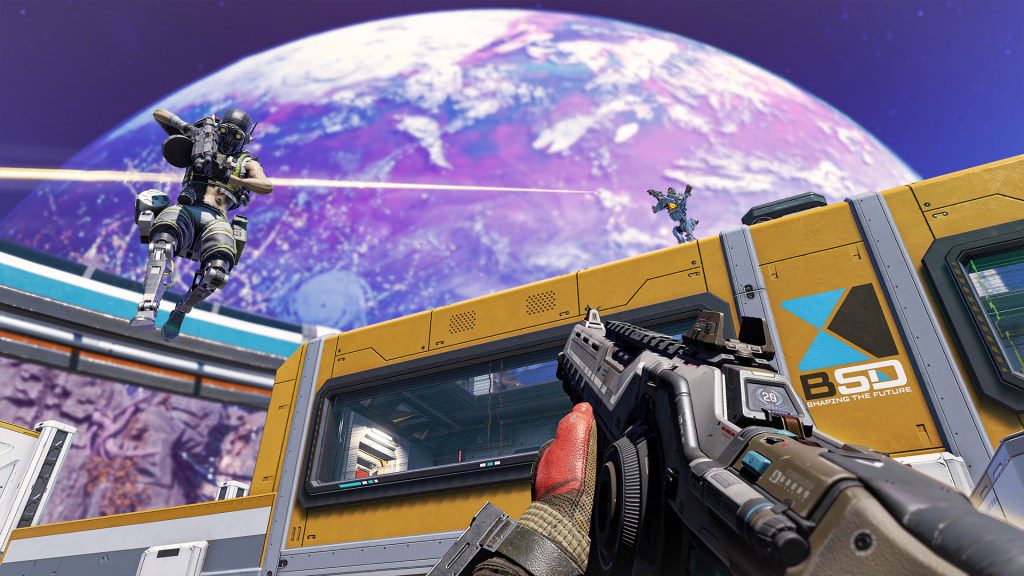
Apex is known for its slick Call of Duty-like gunplay with parkour-esque movement.
Courtesy of EA
On top of the battle royale element, another major differentiator for Apex is that each player must choose a specific character with unique abilities. Called “legends,” each avatar plays slightly differently, some better suited for aggression and damage-dealing, while others function as support helping keep allies alive or charting the best path forward across the terrain. Other games have this, too, like Overwatch or Valorant. Yet those games are limited to small maps with specific lanes and geography to memorize as a strategy, and are limited to two teams of 5v5; it becomes more about choosing the right characters to fit the meta and outplay your opponents.
With a mixed roster of various abilities, and so many external forces at play — including the 60 people all making decisions at once — there’s a lot more to contend with in Apex. It’s like an amalgamation of half a dozen different games, with many overlapping systems to understand and internalize.
Why is it a good esport?
With so much visual information, it might sound difficult for a non-player to comprehend what’s going on at any given time in Apex. And don’t be fooled — it is, at least initially. Essentially, there’s always two different things to keep track of: the 60 individual perspectives (referred to as the “micro” game) and the overarching flow of the match, including each team’s standings and what threats are they facing or instilling upon each other (called “the macro”).
For viewers watching online on platforms like Twitch, understanding both elements is required. While livestream feeds do cycle between different players’ POVs for moment-to-moment action, the need to cycle through so many perspectives (60 vs about 10 in other games), means audiences are always missing something that’s happening. But there are ways to get a more focused look; using apps like FACEIT, which is a livestreaming and competitive gaming hub for organizing and watching tournaments, viewers can actually manually select which player’s perspective they want to see, and swap through each in real time.
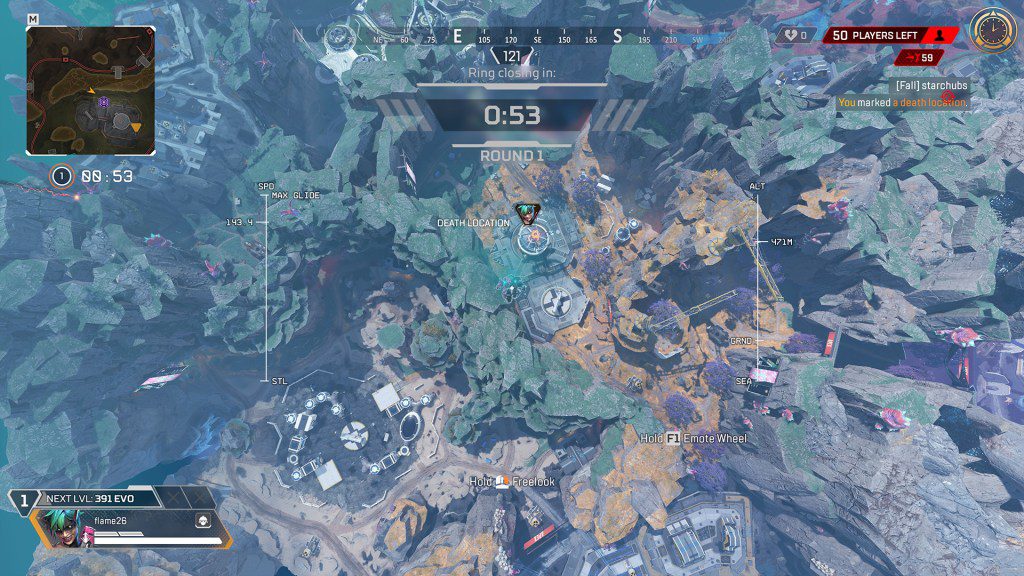
As a battle royale, the play area is massive but always shrinking.
Courtesy of EA
Otherwise, the narrow perspectives are also alleviated by the macro, which is visualized as an overhead world map, where each individual player appears as an icon on the terrain. Watching the map provides all the information about where combatants are moving, what skirmishes they’re engaged in, and where points of convergence may arise.
It’s almost like watching a real-time strategy game from the overhead, seeing the big picture, while the player POVs are inside looks of the action on the ground. The synergy between the two different viewpoints is where the tension lies. Watching your favorite team navigate the perils of the battlefield can be stressful, especially with the godlike omniscience of what’s happening all around them — something the players themselves never know. Seeing all the threats ahead creates a special kind of anxiety, almost a helplessness for fans who are breathlessly waiting to see if their heroes can prevail. It’s like a slow-motion trainwreck, except you might just be rooting for the train.
Obviously, the players themselves need to deal with the pressures of balancing their attention on the micro and macro, too. Evan Verhulst, an American player for the team TSM, describes Apex as a “chess match,” where everyone is trying focus their skills on shooting and moving, while also avoiding running into other groups and getting picked off. Sometimes, they don’t even really know where to go at all. “Most players don’t even know the layouts of the maps because they’re so huge,” he says.
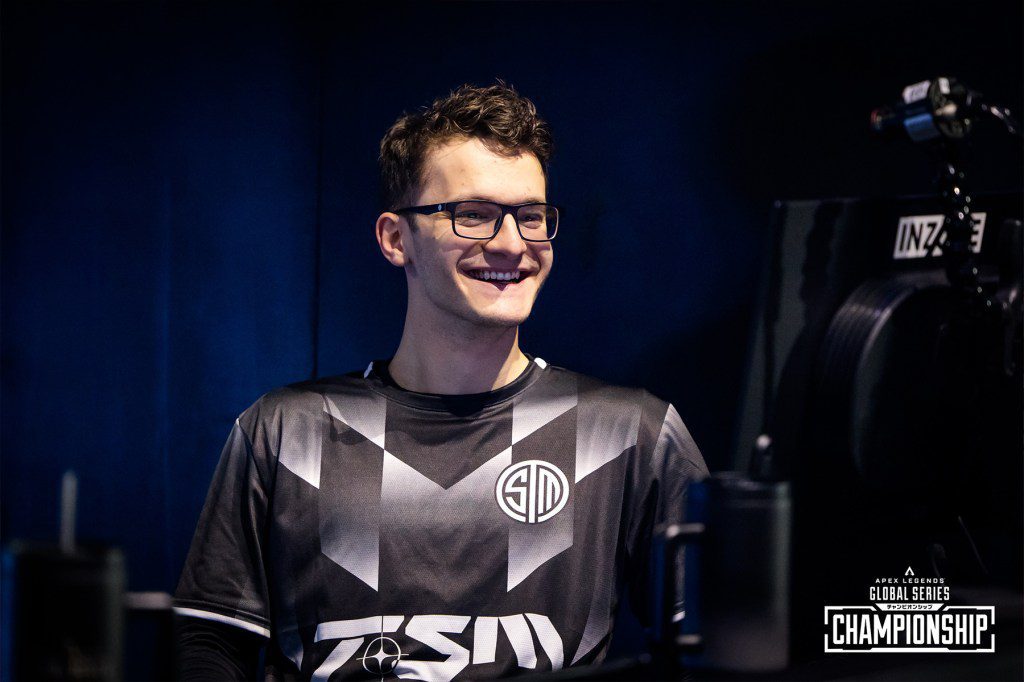
Evan Verhulst plays for TSM.
Courtesy of EA
“I think it’s probably a more complex esport to understand,” Verhulst says. “You definitely have to be closer with your team; you have a lot more control over your teammates [in that] everyone can work together to fix one person’s problem.”
In order to make sense of the chaos, teams often defer to an “In Game Leader” (or IGL), who essentially serves as a captain, steering the ship. “Every team has an IGL, an in-game leader, and that guy is in charge of calling the shots,” Verhulst says. “They’ll make the final call on where to move, position to position. They guide the team through the zones to try and get deeper. They pick which teams to fight, they pick when to back up, when to push.”
Verhults explains that the best way to remain consistently good at Apex isn’t just mastering a specific set of skills or strategy but learning the art of adapting.
That adaptability can be seen throughout the game in moment-to-moment action. Working in tandem with their teammates and utilizing each of their different abilities (like healing, shielding, or resurrection) wisely can keep players alive even when the odds are against them. Unlike other games where a few bullets can quickly down someone, the characters in Apex are a little bit sturdier, capable of taking more damage.
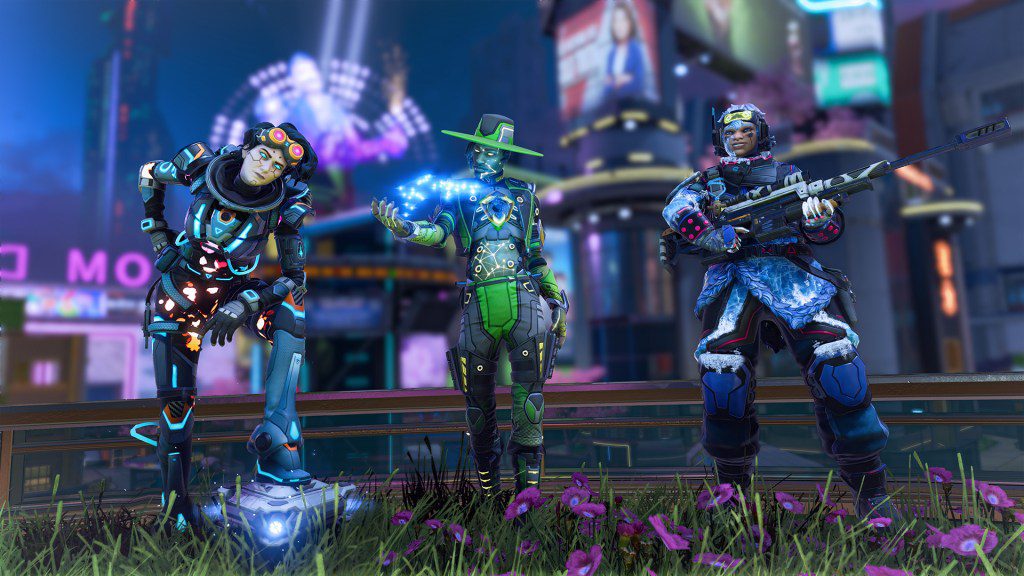
Different legends have unique abilities that change the dynamic of each squad.
Courtesy of EA
Before joining Respawn, John Larson was just a fan. He originally played Call of Duty but fell in love with Apex from the start, partially because of how its systems allowed for more diversity in the ways situations can play out. “My immediate reaction was, ‘This isn’t Call of Duty,’” he says. “It took a lot of bullets to kill a person. When you have a higher time to kill (TTK), you have these changes to the combat dynamic in a way that allows for more outplay potential, whereas sometimes in Call of Duty, you just get caught out and you die. It’s just lower stakes.”
The potential to recover rather than get instantly wiped out helps ratchet the tension of each match, where every encounter may have an out. Clever use of legend abilities or just slick footwork can help keep a team in the game, especially if multiple teams are converging. When situations get hairy, a quick escape could leave your competitors finishing a fight that you ultimately started while later watching in respite.
What’s it like to watch in person?
While it’s enjoyable to watch Apex Legends at home on Twitch or FACEIT, especially with high-quality production value and esports commentary to help paint a picture of the match and delineate the many narratives and stakes — seeing it in person is something else entirely.
On the final day of the competition, the Premist Dome is entirely sold out. What is usually an enclosed soccer field has been converted into a digital age colosseum filled with pyrotechnics and laser light. And even though there’s 13,000 people filling the stands, looming in curvature over the arena, it’s often dead silent other than the sounds of footsteps and gunfire ringing out from the game.

Over 30 thousand people attended ALGS 4 over the course of five days.
Courtesy of EA
The frequent silence stems from the fact that Apex, unlike other esports, is a much slower paced experience. Matches are long, often 30 minutes in length, rather than the rapid-fire rounds of games like Counter-Strike which run in frenetic spurts of two minutes or less. In Apex, the game begins slow, as every team finds their footing and makes their way across the map, only infrequently running into another party (unless they’ve got bad luck). As time goes on, more and more pockets of action arise, accompanied by cheers and boos as squads are abruptly eliminated or skirt away by the skin of their teeth.
There’s a clear ebb and flow to each match, but the nature of the game’s format means that every bout is a long-simmering kettle that’s primed to boil over by the time the storm’s iris forces all survivors together in a face-off to the death. At match point, however, the stadium erupts as fans and players alike finally release the mounting tension they’ve been sitting on.
For any athlete, either tuning out the crowd or playing off their energy becomes part of the game. But for Apex players, hearing the fans roar mid-match can be unsettling; it usually means something big has happened that they’re not yet seeing.
“It’s a different dynamic because when you play at home, you have pretty clear audio,” Verhulst says. “You can hear everything going on, you can hear gunshots, [people] walking around you in-game, you can hear all the footsteps. But when you have a crowd, you can’t really hear any of those little details. We have noise-cleaning headphones; they’re like these big, thick, thousand-dollar aircraft-grade noise-cancelling headphones. Even through those, we can still hear the crowd. That’s just how loud it is.”
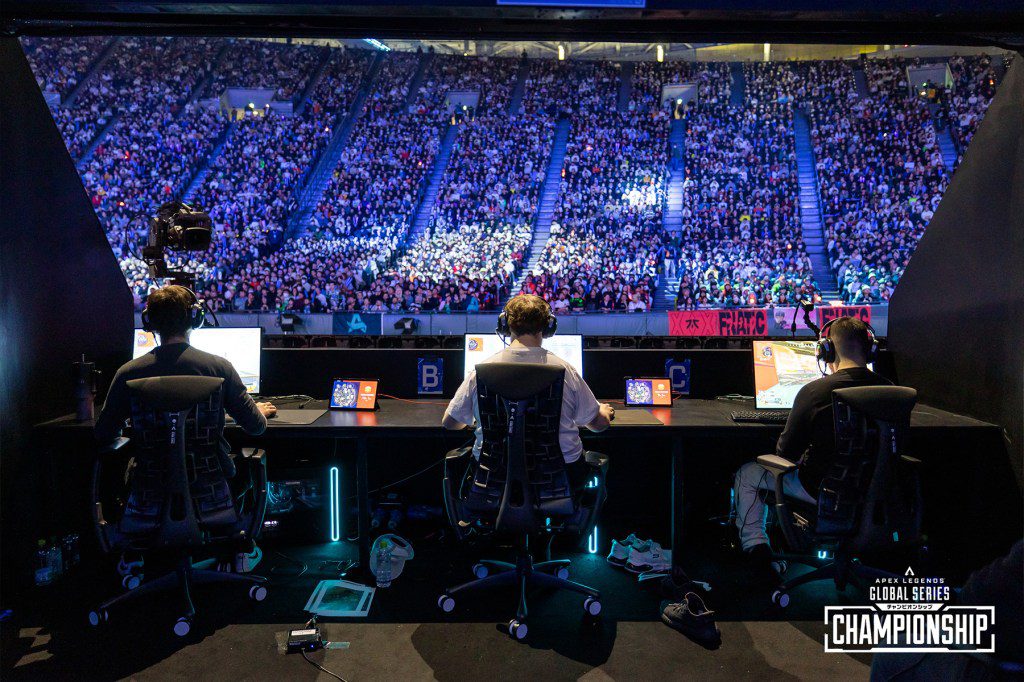
Players are stacked in a two-level structure to accommodate 20 teams at a time.
Courtesy of EA
For players like Verhulst, there’s an additional layer of insulation from the crowd, and other teams too, due to the layout of the arena. Unlike other esports tournaments that have a straightforward main stage, where two teams of five are neatly lined up behind long barrier-like desks either facing each other or the crowd, competitive Apex demands that 20 teams all occupy the space at once. The solution is a feat of engineering.
At Apex Legends Global Series Year 4, the teams are housed in a massive rectangular structure that resembles a high-tech take on elementary school cubbies. With two floors, the squads are neatly tucked into their cubes, ten teams below and the other ten on top. Inside, three players are seated next to each other with their coach overseeing from the rear. It resembles the cockpit of a starship or the inside of a Power Rangers mega-zord.
For the players, the close quarters can be comforting. “Once you sit down in your booth, you kind of forget that there’s other teams around you,” Verhulst says. “You can’t see anybody; all you see is the fans. It feels like you’re just performing for the crowd rather than competing against people sometimes.”
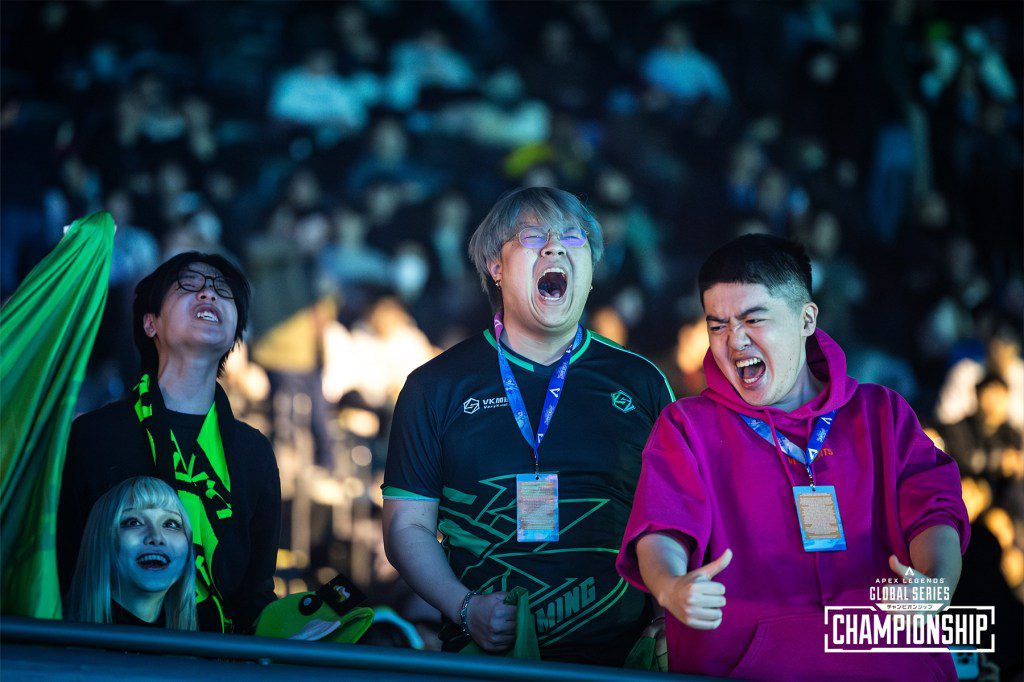
Matches ebb and flow from total silence to roaring cheers.
Courtesy of EA
For fans observing, there’s really only the sights and sounds of the game projected on massive screens to ingest. Like with most traditional sports, you’re not really getting color commentary or play-by-plays from the stadium’s PA system. In between matches, there are broadcast talent talking shop and conducting interviews but, of course, here it’s all in Japanese. To get the full experience, most attendees are watching the tournament with phones in hand, each tuned into either the official broadcast in any number of languages, flipping through each player’s gameplay on FACEIT, or simply listening to their favorite content creator or streamer react to the proceedings in real time. Whereas you might be ridiculed for being glued to your phone at an NBA game, here the competition is an entirely dual-screen experience.
Mark “Onset” Hatcher is a former professional Halo player turned esports caster. He’s one of the voices you’d hear doing in-game commentary during a match. As someone who came up in the scene when it was much more grassroots, he prides himself on bringing ESPN-caliber bravado to the video game world.
“My role is to kind of justify, almost, the time, effort, dedication, and skill it takes to perform some of the things that they do in game,” Hatcher says. “I think coming from a background where I competed myself, you have that intuitive understand of, ‘That’s not easy to do at home. It’s even more difficult to do it live in from of 30,000 people, when you’re playing for $2 million and you only get one shot at it.’ My role is making people appreciate the brilliance that they are actually seeing.”
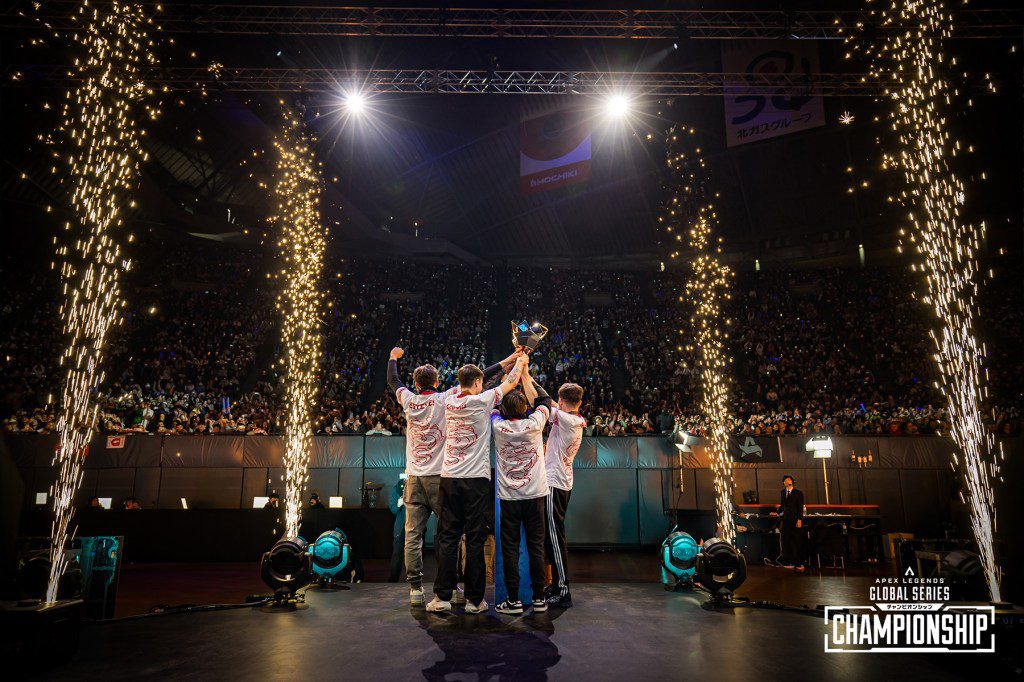
With the match point system, no easy victories are guaranteed.
Courtesy of EA
In the final hours of the tournament, that brilliance is on full display. One aspect of Apex esports that sets it apart from the pack is the unique way in which its championship is crowned. Over five days, 40 teams are whittled down to 20, and the endgame is decided by something called “match point.” In order to be named the winner, a team has to score 50 points (each from a kill) to qualify for the win over the course of several matches, but once they do, they still need to win the final round by surviving. This sounds simple, yet it’s anything but. A team could garner the 50 points needed quickly, yet still end losing match after match by elimination, especially as other squads target them to prevent them from reaching the cap.
On this day, Team Falcons started out as the favorite to win. The first to reach 50 points, all they needed to cinch the victory was survive one match. They just couldn’t. Round after round, they were targeted and denied, with more teams qualifying each go around. By the end, half of the 20 teams had reached the means to win, but none were able, stretching out the tournament for hours. In the end, a late qualifying underdog group called GoNext just barely inched out the victory. Nobody saw it coming.
In a game where every match is a series of cascading variables, the final day Apex Legends Global Series 4 had become an exhausting thrill ride in the exact same way. Although it can be overly complicated, coming to understand Apex Legends means opening your mind to one of the most strategically complex and exhilarating forms of entertainment there is.





